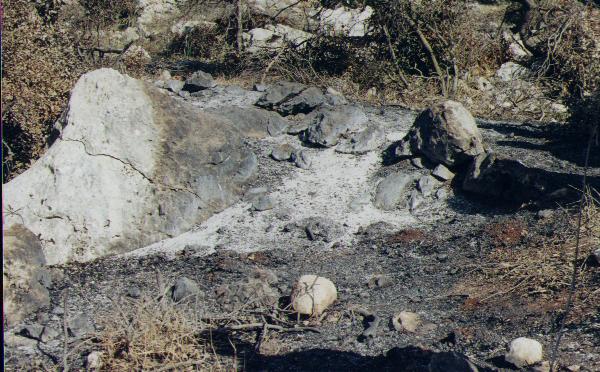
From: http://www.jas.org.jo/mett.html
On 18 April 2001 around 19:30 Local Jordanian Summer Time (UT+3), Mr. Jamal Al-Halabi, the editor in chief of the Associated Press (who is already a friend of JAS), called JAS member Mohammad Odeh asking him about an object he saw in the sky from Amman few minutes ago! From his description it seemed that what he saw was a fireball! Or better a huge fireball! Anyhow, later on a Jordanian Newspaper mentioned that residents of a Jordanian village called Bayt Eides saw a meteorite crashed down in front of more than 100 persons of the residents.
One of the eyewitnesses was Mr. Mohammad Nawwaf Miqdadi, mayor of Bayt Eides. So JAS had directly phoned him asking him about some details, and later on JAS decided to visit that place.
A delegation of JAS consisting of Eng. Khalil Konsul (President of JAS), Mohammad Odeh, and Mohammad Katbeh went to Bayt Eides on Tuesday 24 April. JAS reached the site around 15 Local Time (LT). Where Mr. Miqdadi welcomed JAS and joined JAS to the location.
As JAS arrived the site, we made an interview with him asking him about the details, and JAS took some photos, as well as determining the coordinates of the site. According the GPS, the site is 54.4 Km to the North of Amman (Azimuth 345). Regarding the details, Mr. Miqdadi said:-
On Wednesday 18 April around 07 pm, which is before sunset (Sunset occurs around 07:10 pm) at sundown to bury a village resident, more than 100 persons saw a bright object moving in the sky with a dark yellowish color. The object was moving from west to east, and then it broke up into two parts, which felt on a nearby hill (which is about 1.5 Km from the place at which we were watching!). As the two pieces hit the ground we saw a fire, initially with a greenish color, and then the fire reached up to 5 meters! On the very next day I (Mr. Miqdadi) went to that place and I saw the two locations at which the two parts felt. (Let's call the first location A, and the second one B).
Now JAS is watching and examining the location A, which no one entered yet! The ground is full of ash and it is rather black (from the fire) and so are the stones! What directly brought our attention were two things, the first was a tree trunk which is broken into two parts (See Photo). Mr. Miqdadi said this must be from the object which hit the tree! Actually the appearance of the broken tree trunk is very strange! I don't guess it is a man-made break! The other thing was a half burnt tree (See photo)!
Concerning the location B, which was visited by two persons before JAS, it was also full of ash and black. "The location was full of small rock, but when the object hit the area it made a crater as you can see", Mr. Miqdadi said. Actually there was no real crater! But it was clear that at certain place the level of the rocks is lower than the surrounding, and there is a shape of an arc. Also, a half of a large rock was burnt, while the other half is normal (See Photo)!
We did our best to find a meteorite but I must say that we failed! So the question is what felt then? Did the object totally burnt up? Is this ash the meteorite remnant! Eng. Khalil Konsul said, this is not possible, because if the ash is a meteorite remnant, then the meteorite would be very large and this will make a real trouble! Which was not the case! JAS took a sample of the ash and soil, and we shall send it for analysis.
Lastly, the coordinates of the of the locations are:-
Location A:-
Location B (Which is about 50 meters only away of A):-
The following experts suggested some explanations about this event.
"A meteorite is living in the cosmos and that its temperature, when flying in the outer space is very very low: some ° K, depending on its color. When it enters the earth atmosphere its skin is immediately heated to fusion point then to vaporization point and then burns due to O2 presence in the atmosphere. The burning skin disappears as soon as it melts and vaporizes and the skin is renewed quasi immediately.
Imagine that you take a piece of ice ( at a temperature way below 0°c) and that you put it in an hot air current: The ice will melt and then evaporate and the piece of ice will diminish in size. If you stop the hot air flow, the remaining part of your initial ice will still be solid and cold, with only a thin layer in liquid state. This thin layer will re-freeze quickly. The phenomena with meteorite is very similar ( the difference being that the vapor created by friction burns).
For stone meteorites, it is easily understandable that the temperature of the meteorite stays cold.
For irons, you asked the right question, but in fact, it is the same phenomenon. You may know that the elapsed time between upper atmosphere layer and extinction point is some tens of seconds. More likely 10 to 20. After the extinction point the meteorite has a free fall speed as will have any body thrown from an airplane.
Usually, small mass meteorites( below 1 ton ) reach the ground having lost all its cosmic velocity. The point at which all its sped is lost is called retardation point , which is very close to extinction pint ( when it stops burning).
In the case of your phenomenon, the fireball was seen reaching the ground, which will be possible for a more than one ton meteorite, having kept some of its cosmic velocity, such an object will have made an impact hole , (impact crater), some meters deep. Such a crater was not found in Bayt Eides. The remarkable impact site photos than you put on line on your site are not familiar to those who have seen meteorite impact holes.
This means that the object was too small to make a crater but was still burning ( i.e. with a cosmic velocity) These two circumstances are contradictory.
Your decision to proceed to analysis of the ashes is certainly a very good decision and will reveal the origin of the undetermined flying body.( or at least help to choose between human, terrestrial, or extraterrestrial ).
Satellite debris are different from iron meteorites because they are mainly not as compact as irons, and because satellite debris may hold light elements like coatings or paint or organic material like plastic or man made elements of low compaciry. Remember that on satellite the weight is the enemy and all except structural "bones" is very light."
"The absence of any meteorites and character of destruction completely confirm my earlier proposal that it was sooner a geophysical event, which I prefer to call a "geophysical meteor". Currently I am collecting geophysical data on the event, and suppose to post it in Internet. The last well-known example was in Salisbury, USA half a year ago. You can read my preliminary analysis at www.geocities.com/olkhov/gr1997.htm"

Location A (Notice the half burnt rock).
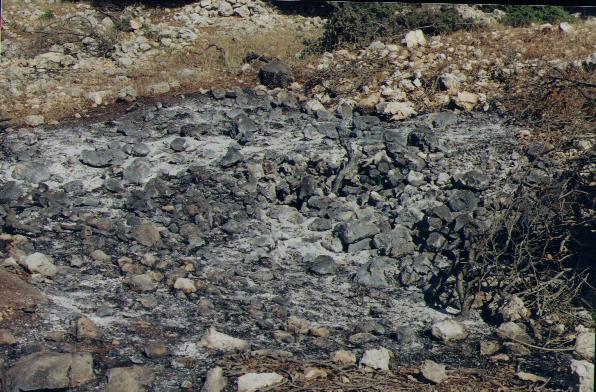
Location B
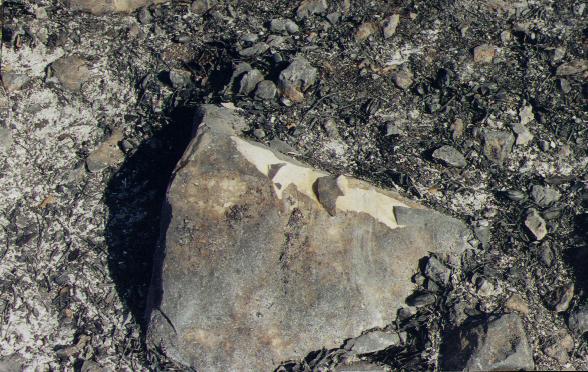
Exfoliation of a rock, due to heat!
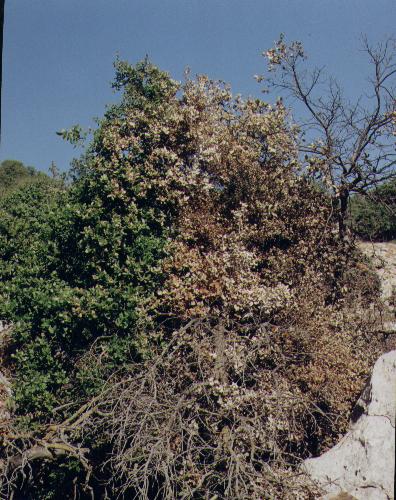
The half burnt tree!
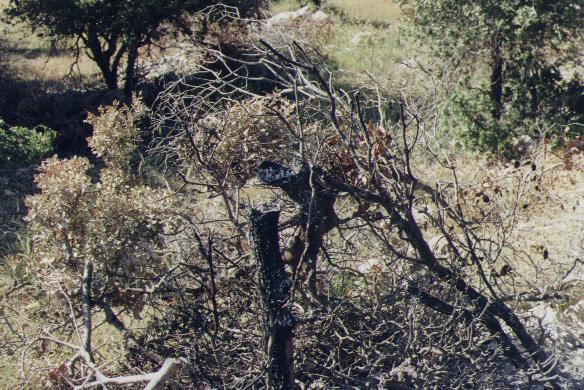
The broken tree trunk!
Jordanian Astronomical Society (JAS), All Rights Reserved. For more information Send E-mail or contact us at :The Jordanian Astronomical Society (JAS), P.O.Box 141568, Amman 11814 Jordan